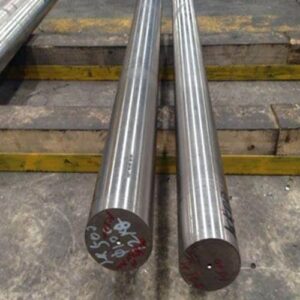Introduction

D2 tool steel is renowned for its high wear resistance and excellent hardness retention, making it a popular choice in industrial applications requiring cutting tools and dies. This blog explores the intricate process of heat treating D2 tool steel round bars to achieve optimal mechanical properties.
Chemical Composition and Properties of D2 Tool Steel
Before delving into heat treatment specifics, it’s crucial to understand the composition and inherent properties of D2 tool steel. This section will discuss the alloying elements and the resultant mechanical properties such as hardness and toughness.
Heat Treatment Process Overview
The annealing process in D2 tool steel begins by heating the material to a specific temperature range, typically around 850-900°C (1562-1652°F), followed by a controlled cooling rate. This slow cooling allows for the reduction of internal stresses and the refinement of the steel’s grain structure, thereby improving machinability and minimizing distortion during subsequent processing steps.
Hardening of D2 tool steel involves heating the material to a critical temperature range, usually between 1000-1050°C (1832-1922°F), followed by quenching in oil or air to achieve a fully hardened martensitic structure. This rapid cooling ensures high hardness and wear resistance, crucial for cutting tools and dies operating under severe conditions.
Tempering, the subsequent step after hardening, involves reheating the hardened steel to a lower temperature, typically between 150-500°C (302-932°F), to achieve the desired balance between hardness and toughness. This process relieves internal stresses and refines the microstructure, enhancing the steel’s ability to withstand impact and resist deformation during use.
Optional cryogenic treatment further enhances the properties of D2 tool steel by subjecting it to temperatures below -100°C (-148°F) for an extended period. This treatment transforms retained austenite into martensite and improves dimensional stability, resulting in increased wear resistance and extended tool life in demanding applications.
Annealing of D2 Tool Steel Round Bar
Annealing is the initial step in heat treatment, aimed at relieving internal stresses and achieving a uniform microstructure. This section will detail the annealing process parameters such as temperature and cooling rate to refine the grain structure.
Hardening of D2 Tool Steel Round Bar
Hardening involves heating the steel to a specific temperature range followed by rapid quenching to achieve high hardness. Factors affecting hardening, such as quenching media selection and agitation methods, will be thoroughly discussed.
Tempering of D2 Tool Steel Round Bar
Tempering is a critical step to balance hardness and toughness by reheating the hardened steel to a lower temperature. This section will cover the tempering temperature ranges and their effects on the final mechanical properties of D2 tool steel.
Cryogenic Treatment (Optional)
Cryogenic treatment, though optional, can further enhance the properties of D2 tool steel by transforming retained austenite and improving dimensional stability. This section will explore the benefits and recommended practices for cryogenic treatment.
Case Studies and Practical Applications
This section will provide case studies or examples of how properly heat-treated D2 tool steel round bars perform in real-world applications. It will highlight the correlation between heat treatment processes and specific industrial uses.
Comparison of Mechanical Properties after Different Heat Treatments

| Heat Treatment | Hardness (HRC) | Toughness (J/cm²) | Wear Resistance (mm³) |
|---|---|---|---|
| Annealed | 20-25 | Medium | Low |
| Hardened | 58-62 | Low | High |
| Tempered | 55-60 | Medium-High | High |
| Cryo-treated | 60-64 | High | Very High |
Conclusion
In conclusion, mastering the heat treatment of D2 tool steel round bars is essential for achieving the desired balance of hardness, toughness, and wear resistance. Properly executed heat treatment processes ensure optimal performance and longevity in industrial applications.
FAQ
What is the recommended preheat temperature for D2 tool steel round bars?
- Typically, a preheat temperature of 750-800°C (1382-1472°F) is recommended to minimize thermal shock during subsequent heating processes.
How does the hardness of D2 tool steel change with different tempering temperatures?
- Hardness decreases as tempering temperature increases. For D2 tool steel, tempering between 150-500°C (302-932°F) achieves various hardness levels suitable for different applications.
Is cryogenic treatment necessary for all D2 tool steel applications?
- No, cryogenic treatment is optional but can enhance wear resistance and dimensional stability, particularly in high-performance tooling applications.
How does the carbon content affect the hardenability of D2 tool steel?
- Higher carbon content increases hardenability, allowing for deeper hardening during heat treatment, which enhances wear resistance and toughness.
What are the common quenching media used for hardening D2 tool steel?
- D2 tool steel is typically quenched in oil or air to achieve desired hardness levels, depending on the specific application requirements and steel dimensions.
